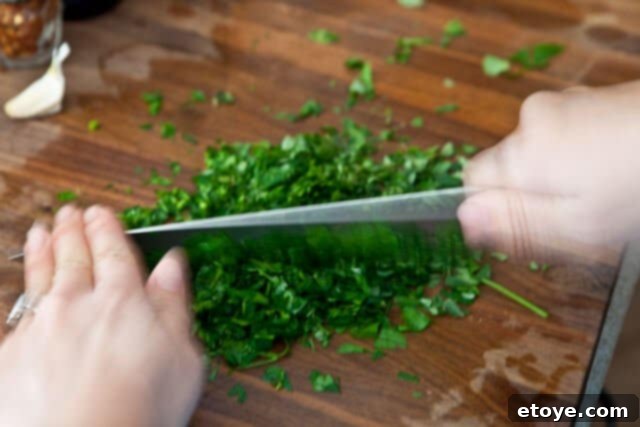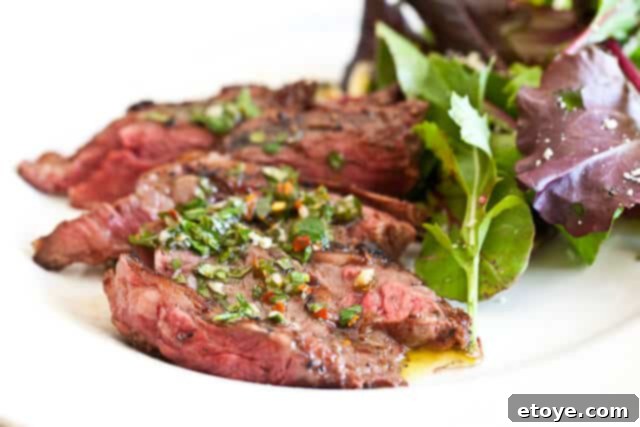
Elevate Your Grill Game: The Ultimate Guide to Authentic Chimichurri Sauce
Imagine a sauce that can single-handedly transform any grilled meat, seafood, or vegetable into a culinary masterpiece. A sauce so vibrant, so fresh, and so packed with flavor that it becomes an instant favorite. This isn’t just a dream; it’s the reality of chimichurri, Argentina’s iconic herbaceous condiment. Known for its bright, garlicky, and subtly spicy kick, authentic chimichurri is an essential component of any great barbecue, offering a burst of freshness that cuts through the richness of grilled dishes. If you’re looking to enhance your cooking with bold, unforgettable flavors, mastering homemade chimichurri is your next step.
My own journey with chimichurri began with a memorable experience at a lively Los Angeles restaurant. Alongside a perfectly grilled skirt steak, a small ramekin of vivid green chimichurri sauce was presented. With each bite, the sauce’s tangy, garlicky punch amplified the steak’s rich flavor, creating an irresistible combination. My requests for refills were frequent, and by the meal’s end, the insightful waiter, noticing my profound appreciation, graciously handed me a quart-sized container to take home. That night, he received an exceptional tip, and I gained an enduring passion for this magnificent Argentinian sauce.
What is Chimichurri? Unveiling Argentina’s Essential Condiment
At its core, chimichurri is an uncooked sauce originating from Argentina, where it holds a revered place in the country’s celebrated ‘asado’ (barbecue) culture. It functions both as a vibrant marinade and a flavorful table condiment, designed to complement the smoky depths of grilled meats. While the exact origin of its intriguing name is debated – some suggest it’s a linguistic twist on “Jimmy’s curry,” while others point to native terms – its purpose has always been crystal clear: to invigorate and elevate the flavors of simple, high-quality grilled fare.
The foundation of any truly authentic chimichurri sauce rests on a few key ingredients: finely chopped fresh parsley, pungent garlic, rich olive oil, and sharp red wine vinegar. These core components are non-negotiable, forming the backbone of its distinctive taste. However, chimichurri recipes can vary subtly from town to town and family to family across Argentina. Some versions incorporate fresh oregano for added aromatic depth, while others include a touch of crushed red pepper flakes for a gentle warmth. This particular version, inspired by the culinary wisdom of Francis Mallmann and his acclaimed book “Seven Fires: Grilling the Argentine Way,” beautifully captures the essence of classic chimichurri, delivering a balanced and deeply satisfying flavor profile.
The Irresistible Flavor Profile of Authentic Homemade Chimichurri
What sets chimichurri apart and makes it so incredibly addictive? It’s the masterful interplay of its fresh and potent ingredients. The bedrock of its flavor comes from fresh flat-leaf parsley, which provides a clean, earthy, and slightly peppery base. This is beautifully complemented by fresh oregano, which contributes a warm, aromatic, and slightly bitter note that adds complexity. Finely minced garlic delivers a robust, savory kick, which is then balanced by the bright, tangy acidity of red wine vinegar. The entire concoction is emulsified and enriched by high-quality extra virgin olive oil, which also helps to carry and distribute the flavors. Finally, a hint of crushed red pepper flakes introduces a subtle, lingering warmth that gently awakens the palate without overpowering the delicate nuances of the herbs.
While some historical or more rustic variations of chimichurri, particularly those favored by the nomadic Argentinian gauchos, might have utilized dried herbs for convenience, the pinnacle of chimichurri flavor is undeniably achieved with fresh ingredients. The vivid, almost emerald-green hue of fresh chimichurri is not merely for visual appeal; it signals the intense vitality and lively taste that dried herbs simply cannot replicate. Opting for fresh parsley and oregano ensures a brighter, more aromatic, and ultimately more captivating sauce that truly embodies the spirit of Argentinian cuisine. Once you experience the difference that fresh ingredients make, you’ll understand why this sauce quickly becomes an indispensable part of your culinary repertoire, ready to be slathered on virtually everything.
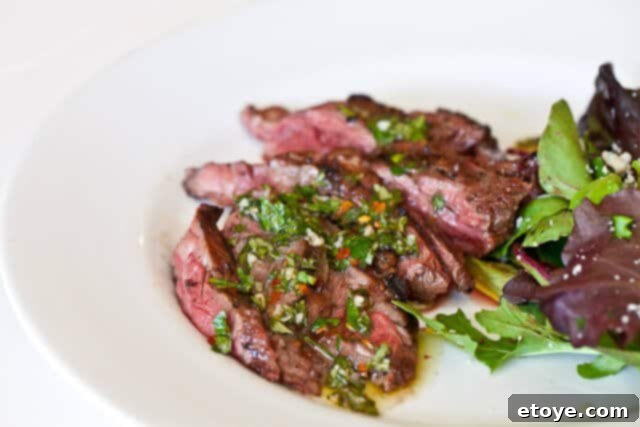
Beyond Steak: The Incredible Versatility of Chimichurri Sauce
While chimichurri is famously paired with grilled steak, particularly cuts like skirt steak, its culinary applications are incredibly diverse. Its vibrant, fresh, and acidic profile makes it a remarkably versatile condiment that can elevate a wide array of dishes, making it a true workhorse in the kitchen. Think of it as a flavor-packed secret weapon that can transform everyday meals into something special.
Explore the Many Uses for Chimichurri:
- **A Dynamic Marinade:** Chimichurri excels as a marinade. The acidity from the vinegar helps to tenderize meats, while the powerful combination of herbs and garlic infuses deep, savory flavors. It works wonders on chicken breasts, pork tenderloin, or even firm-fleshed fish such as salmon, cod, or swordfish. Marinate for at least an hour, or up to several hours, before grilling, roasting, or pan-searing.
- **The Ultimate Finishing Sauce:** This is arguably its most celebrated role. Spoon generous amounts of freshly made chimichurri over hot, grilled meats, poultry, or seafood. The residual heat from the cooked dish gently warms the sauce, causing its aromatic oils to bloom and release their full fragrant potential. It’s equally fantastic drizzled over roasted vegetables, providing a bright, tangy contrast to their caramelized sweetness. Imagine it over roasted red bell peppers, hearty portobello mushrooms, or golden-brown potatoes!
- **Elevate Your Vegetables:** Don’t limit chimichurri to just meats. Toss warm roasted or grilled vegetables with a spoonful of the sauce for an instant flavor boost. It pairs exceptionally well with asparagus, zucchini, green beans, or even fresh corn on the cob, adding a vibrant twist.
- **Sandwich and Wrap Enhancement:** Replace your usual mayonnaise or mustard with a thin spread of chimichurri on sandwiches, wraps, or even homemade burgers. It adds an unexpected layer of fresh, herbaceous flavor that truly awakens the palate.
- **Breakfast Brilliance:** A simple drizzle of chimichurri over scrambled eggs, fried eggs, or a fresh omelet can transform a mundane breakfast into a gourmet experience.
- **Vibrant Salad Dressing:** Whisk a bit more extra virgin olive oil and a splash of water or lemon juice into your chimichurri to thin it out slightly, creating an incredibly flavorful and unique salad dressing.
- **Artisan Bread Dipper:** Serve chimichurri in a small bowl with warm, crusty bread or focaccia. It’s a delightful appetizer or a sophisticated alternative to plain olive oil for dipping.
With a batch of homemade chimichurri stored in your refrigerator, you’ll discover countless opportunities to infuse your daily meals with exciting, authentic Argentinian flavor. Its versatility ensures that it will quickly become one of your most reached-for condiments.
Crafting Your Own: How to Make Homemade Chimichurri Sauce
Making chimichurri from scratch is a surprisingly straightforward process that yields incredibly delicious results. The secret to its outstanding flavor lies in the quality and freshness of your ingredients. Here’s a detailed guide to creating your own batch of this sensational sauce:
Key Ingredients for Your Homemade Chimichurri:
- **Fresh Flat-Leaf Parsley:** You’ll need about 1 cup, tightly packed, finely chopped. This herb provides the foundational fresh, green flavor.
- **Fresh Oregano Leaves:** Approximately 1 cup, finely chopped. While dried oregano is sometimes used in a pinch, fresh is highly recommended for its vibrant aroma and taste.
- **Garlic:** About 4 cloves, minced. Fresh garlic is crucial for that characteristic pungent kick.
- **Crushed Red Pepper Flakes:** Start with 2 teaspoons, and adjust to your preferred level of heat. This adds a gentle warmth that complements the other flavors.
- **Red Wine Vinegar:** 1/4 cup. This provides the essential tangy, acidic component. White wine vinegar or fresh lemon juice can be used as alternatives for a slightly different flavor profile.
- **Extra Virgin Olive Oil:** 1/2 cup. A good quality olive oil is important for richness and to carry the flavors.
- **Sea Salt:** To taste. Essential for balancing and enhancing all the other ingredients.
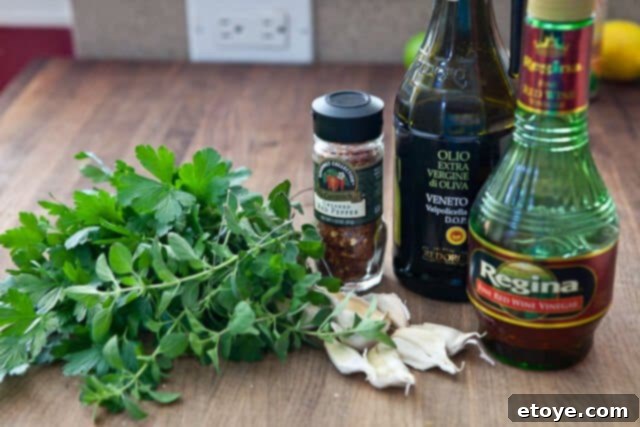
Step-by-Step Preparation:
- **Prepare Your Herbs and Garlic:** Begin by thoroughly washing and drying your fresh parsley and oregano. Finely chop both herbs. The finer the chop, the better the flavors will meld. Next, mince your garlic cloves. While a food processor can speed up this process, be careful not to over-process, as you want a finely chopped texture, not a smooth purée. Hand-chopping will yield a more traditional, rustic consistency.

- **Combine Dry Ingredients:** In a medium-sized mixing bowl, combine the finely chopped parsley, oregano, minced garlic, crushed red pepper flakes, and a pinch of sea salt. Stir these dry components together to distribute them evenly.

- **Incorporate Liquids:** Pour the red wine vinegar over the herb mixture, followed by the extra virgin olive oil. Stir vigorously to combine all ingredients until they are thoroughly mixed. The herbs should be suspended evenly within the oil and vinegar mixture, creating that classic vibrant green appearance.
- **Season to Perfection:** This is perhaps the most crucial step for a truly outstanding chimichurri. Taste a small spoonful and adjust the seasoning as necessary. You may find it needs a little more salt to bring out the flavors, an extra splash of vinegar for tang, or a few more red pepper flakes for an added kick. Continue tasting and adjusting until you achieve a perfect balance of fresh, tangy, garlicky, and slightly spicy notes.

Storage and Serving Tips:
Your freshly prepared chimichurri is ready to be enjoyed immediately. However, its flavors tend to deepen and harmonize beautifully if allowed to rest for at least 30 minutes at room temperature before serving. For longer storage, transfer the chimichurri to an airtight container and refrigerate it. Thanks to the natural preserving qualities of the vinegar, it will remain fresh and vibrant for up to 2-3 weeks. Before serving after refrigeration, allow it to sit at room temperature for about 15-20 minutes. This will help the olive oil to loosen and the full spectrum of flavors to emerge, ensuring the best possible taste experience.
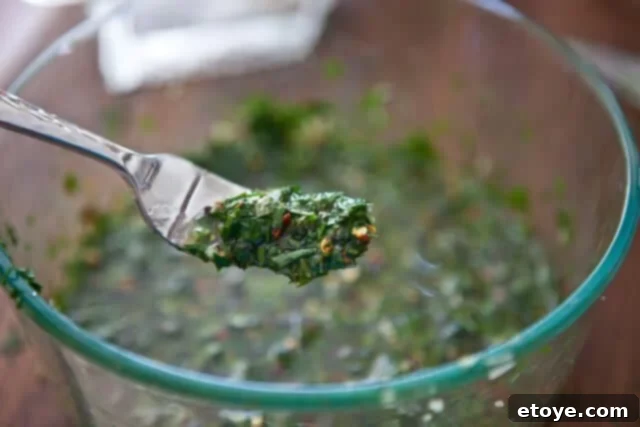
The Perfect Pairing: Skirt Steak with Chimichurri Sauce
Among the countless culinary partners for chimichurri, grilled skirt steak stands out as an undeniable classic and a favorite for many, including myself. This particular cut of beef is celebrated for its robust flavor and its ability to become incredibly tender when cooked correctly. Its relatively thin profile and rich marbling make it an ideal canvas for soaking up the vibrant, acidic, and herbaceous notes of chimichurri. The steak’s inherent richness and deep beefy taste create a beautiful equilibrium with the sauce’s bright and tangy character, resulting in a dining experience that is both bold and exquisitely balanced.
Achieving perfectly grilled skirt steak requires a high-heat, quick-cook method to develop a fantastic sear on the exterior while keeping the interior juicy and tender. Because skirt steak is thin, it cooks rapidly, so vigilance is key. Once removed from the grill, the importance of resting cannot be overstated; allowing the steak to rest for several minutes enables the juices to redistribute throughout the meat, ensuring maximum succulence in every bite. The final, crucial step is to slice the steak against the grain into thin strips. This technique effectively shortens the muscle fibers, making the steak incredibly tender and easy to chew. Serving these perfectly cooked and sliced pieces of skirt steak with generous dollops of fresh chimichurri is the ultimate reward, promising a mouthful of authentic Argentinian flavor that will transport your taste buds straight to a traditional asado.
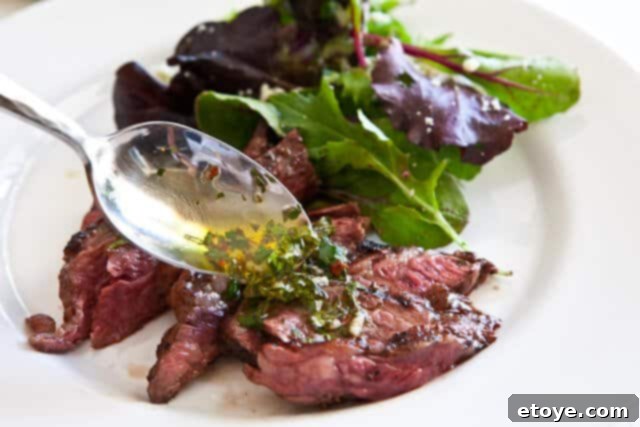

A Closer Look at Red Pepper Flakes
Red pepper flakes, a common and welcome addition to many chimichurri recipes, provide that delightful hint of warmth and gentle heat without ever overwhelming the fresh, vibrant herbs. These small, potent specks are derived from various members of the extensive *Capsicum* family, a genus renowned for its diverse range of chili peppers. More than just a simple seasoning, red pepper flakes are a global culinary marvel, cherished for their ability to add a subtle kick and depth to an enormous variety of dishes.

Botanically Speaking: The Diverse World of *Capsicum*
The *Capsicum* genus, with its origins rooted deeply in the New World (the Americas), is a fascinating plant family known for its often “hot-headed” members and incredible journey around the globe. From the mild sweetness of bell peppers to the intense heat of habaneros, *Capsicum* varieties have firmly established their presence in cuisines worldwide, becoming indispensable wherever a little sass and fiery personality are desired to invigorate taste buds. Cayenne pepper, commonly found in powdered form, is derived from the dried, fully ripened fruit of *Capsicum annuum*. This plant belongs to the *Solanaceae* (nightshade) family, which also includes familiar produce like tomatoes and potatoes. Even hotter, smaller, and often pointed “bird’s eye” chilies typically hail from the *Capsicum frutescens* species, illustrating the vast diversity and distinct characteristics found within this remarkable plant group.
The “Yum Factor”: Why We Crave That Heat
In every form, from fresh to dried flakes, red pepper imparts a distinctive pungent heat and a welcome bite to culinary creations. It possesses an incredible power to transform the ordinary into the extraordinary—imagine turning a simple homemade burger into a flavor firecracker, infusing a seafood stew with tantalizing warmth, or supercharging the complexity of salsas, chili powders, marinades, and rubs. By incorporating red pepper, you join a global community of cooks who have embraced its fiery charm across continents. From the sun-drenched kitchens of Italy and the spice markets of India to the vibrant culinary traditions of Mexico and the Caribbean islands, red pepper is a universal language of flavor. Including red pepper flakes in your chimichurri not only provides a pleasant level of heat but also adds a layer of intricate complexity that beautifully harmonizes with the fresh, herbaceous notes.
A True Globetrotter: The Journey of Red Pepper
Native to the Western Hemisphere, with its ancestral home in Mexico, Central and South America, and the West Indies, red pepper embarked on an astonishing global journey following its discovery by European explorers. It traveled extensively, from the New World to the Old World and back again, firmly establishing itself as an indispensable ingredient in countless global cuisines. Today, India stands as a leading producer of various chili peppers, a testament to the spice’s successful widespread adoption and cultivation far beyond its original habitat. Intriguingly, despite its genuine origins, many people historically assumed the pepper was named after the port city of Cayenne in French Guiana, a misconception that speaks to its far-reaching global impact and sometimes complex historical narratives.
Ultimately, whether you are a seasoned grill master perfecting your technique or a home cook looking to infuse your meals with fresh, exciting flavors, making your own chimichurri is an immensely rewarding endeavor. It beautifully demonstrates how a handful of simple, high-quality ingredients, when expertly combined, can create a sauce that is both intensely flavorful and incredibly versatile. So, gather your freshest herbs, mince your garlic with care, and prepare to transform your culinary adventures with this vibrant Argentinian sensation. The delightful tang, the herbaceous aroma, and the subtle heat of homemade chimichurri await to elevate your next meal.
Other Inspiring Chimichurri Creations
Once you’ve mastered the basic chimichurri, you’ll find endless ways to enjoy it. Explore more creative applications with these fantastic recipes from across the web:
- Cowboy Steak with Chimichurri Sauce – Simply Recipes
- Cilantro Chimichurri – Eclectic Recipes
- Chimichurri Sauce – Use Real Butter (exploring dried oregano)
- Steak with Mint Chimichurri – No Recipes
- Grilled Ahi Tuna with Avocado Chimichurri – Poor Girl Eats Well
- Salmon with Chimichurri Sauce – My Colombian Recipes
- Short Ribs with Chimichurri Sauce – From Argentina With Love
- Balsamic Chimichurri – Laylita’s Recipes
- Grilled Baby Artichokes with Mint Chimichurri – Food 52
- Steak with Chimichurri – Food Stories
Skirt Steak with Chimichurri Sauce Recipe
This recipe yields a generous amount of vibrant chimichurri, enough to enjoy with another meal, and keeps beautifully in the refrigerator for 2 to 3 weeks. For a slight variation in tang, feel free to substitute white wine vinegar or fresh lemon juice for the red wine vinegar. While skirt steak is my absolute favorite for this dish due to its rich flavor and texture, this chimichurri pairs wonderfully with any grilled cut of steak you prefer.
Prep Time: 15 mins
Cook Time: 15 mins
Servings: 4
Ingredients
FOR THE CHIMICHURRI:
- 1 cup packed fresh flat-leaf parsley leaves, finely chopped
- 1 cup fresh oregano leaves, finely chopped
- 4 cloves garlic, minced
- 2 teaspoons crushed red pepper flakes (or adjust to taste)
- 1/4 cup red wine vinegar
- 1/2 cup extra virgin olive oil
- Sea salt, to taste
FOR THE SKIRT STEAK:
- 2 pounds skirt steak, excess fat trimmed
- Salt and freshly ground black pepper, to taste
Instructions
- **Prepare the Chimichurri:** In a small bowl, combine all the ingredients for the chimichurri: the finely chopped parsley, oregano, minced garlic, crushed red pepper flakes, red wine vinegar, extra virgin olive oil, and sea salt. Stir thoroughly until all components are well integrated. Taste the sauce and adjust the seasoning as needed, adding more salt, vinegar, or pepper to achieve your desired balance of flavors.
- **Grill the Skirt Steak:** Generously season both sides of the skirt steak with salt and freshly ground black pepper. Preheat your grill to high heat. Place the seasoned steak on the hot grill and cook for 2-3 minutes per side to achieve a beautiful, caramelized sear. If your skirt steak is approximately 1/2 inch thick or less, this cooking time should be sufficient for medium-rare. For thicker cuts, reduce the heat to medium, cover the grill, and continue cooking for an additional 2 minutes to reach medium-rare doneness.
- **Rest and Serve:** Once cooked to your preference, remove the steak from the grill and let it rest on a clean cutting board for at least 5 minutes. This crucial resting period allows the juices to redistribute throughout the meat, ensuring maximum tenderness and flavor. After resting, slice the steak thinly against the grain. Serve the sliced skirt steak immediately, topped with generous spoonfuls of the freshly made Chimichurri Sauce.
Notes
This vibrant chimichurri recipe draws inspiration from the exceptional culinary principles outlined in Seven Fires: Grilling the Argentine Way by the celebrated chef Francis Mallmann.
Embrace the vibrant flavors of Argentina and allow this incredible homemade chimichurri sauce to become your indispensable companion for all future grilling adventures. Its ease of preparation and phenomenal taste promise to transform your meals into memorable culinary experiences. Happy cooking!

